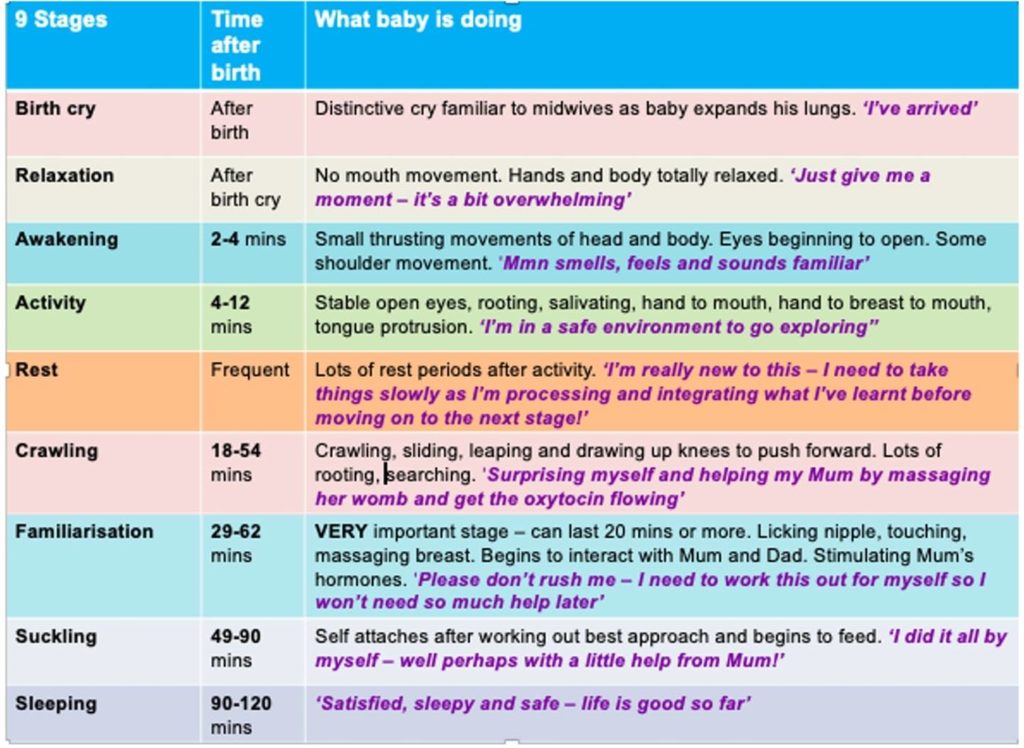Skin to Skin – more than a “warm and fuzzy” feeling!
Most expectant mothers have probably heard about “The Golden Hour” after baby is born. Ideally, the mother and her newborn are enabled to share this intimate time of discovery without interruption or interference from anyone, for at least one hour. Their skin to skin contact stabilises baby’s heartrate, breathing and temperature, and baby proceeds to demonstrate a predictable series of responses and movements which are integral and essential to achieve his first breastfeed after birth. More is now understood about this important sequence called the 9 Stages of breastfeeding, which baby has been practicing in the womb. Research has revealed that these movements are consistently observed in a particular order, and if interrupted, baby needs to resume the sequence at the beginning and complete all stages to successfully attain the goal – the first breastfeed. This lays the foundation for baby’s breastfeeding skills which will rapidly develop in tandem with his mother’s responses and confidence. Unfortunately research has also revealed that very few mother/baby dyads actually complete this foundational process due to time constraints in birth suites and operating recovery rooms, or because a caregiver or family member “helped” the baby to find the breast, latch and feed. If the Golden Hour has been missed or cut short because of a clinical problem, the 9 stages of breastfeeding can be enabled with mother and baby skin to skin at a later time.
The science and biology of mother/baby chemistry during skin to skin contact is fascinating and primal. It is a complex interplay of sensations which establish their life-giving attachment following birth, and that is breastfeeding. The mother’s smell, both from her body but also specifically from her breasts, cause specific brain pathways to fire to the front of the baby’s brain. Smell also sends signals directly to the Amygdala – the emotional processing unit of the brain. It sends a reassuring message (to the baby) that he or she is safe – hence the calming effect skin to skin contact has on baby’s heart rate and breathing. Dr Nils Bergman explains “direct skin to skin contact triggers the amygdala to fire another signal to the prefronto orbital cortex – the activation centre for orientation. Consequently skin to skin contact activates signals to the left side of the brain, and the baby reacts by being orientated to approach, in anticipation of reward.” Dr Bergman elaborates further about how development of these brain pathways lays the foundation for the development of the child’s Emotional Intelligence and Social Intelligence.
But wait, there’s more! The behaviours of the newborn send sensory signals to the mother’s brain that have a profound effect on her too. Skin to skin contact and face to face communication with her baby stimulates the release of oxytocin, the love hormone, which, as she gazes intensely at her baby’s face stimulates the release of even more oxytocin. “A mother’s fear centre is inhibited by high oxytocin levels making her fearless to protect her baby. Working with dopamine, caring for her baby is addictively rewarding as the same approach pathway fired in the baby’s brain is also fired in the mother’s brain”. Close contact with baby nuzzling and suckling at the breast causes the release of prolactin which stimulates milk production, while oxytocin release stimulates the “letdown reflex” enabling the colostrum, and later the milk, to flow as the baby breastfeeds. The mother becomes highly sensitised and tuned in to her baby, enabling her to understand her baby’s signals, needs and wants.
Skin to Skin contact is integral to establishing bonding for both breastfeeding and bottle feeding mothers. I emphasise the particular benefits for bottle fed babies who can often miss out on skin to skin contact over the early days and weeks of life. It is enormously beneficial for mothers who are bottle feeding their newborn to hold baby skin to skin often, especially if she is expressing her breastmilk to feed her baby. When a mother cuddles and carries baby enabling frequent and prolonged skin contact, she stimulates both her own and her baby’s brain to fire signals to the amygdala, enhancing the essential bonding and attachment process between mother and baby.
References from Academy of Breastfeeding Medicine: https://storify.com/BFMedicine/dr-nils-berman ; Nils Bergman on The Neuroscience Behind the Skin-to-Skin Imperative #ABM16 http://ow.ly/w0c43057J5L


